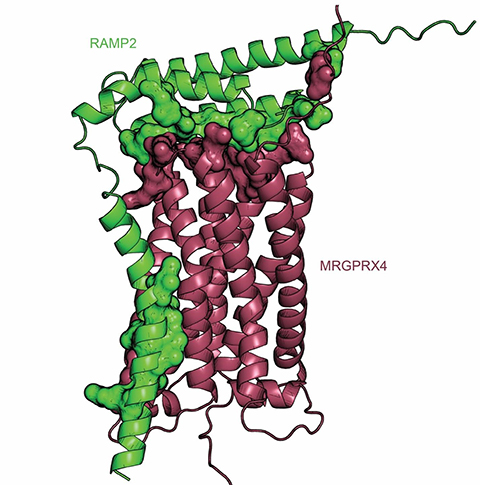Receptor regulation clues may scratch an itch
Whether you’ve been stung by an insect or suffer from allergies, most people have experienced itchy skin, which usually can be relieved with time or simple remedies. However, for certain patients with liver disease, an intense itching sensation, known as cholestatic pruritis — the medical term for itch — often does not respond to standard treatments.

Thomas Sakmar’s lab at the Rockefeller University uses biochemical and biophysical methods to study transmembrane signal transduction by G protein-coupled receptors. GPCRs play an important role in human physiology; they make up the largest family of membrane proteins and mediate many signaling pathways. Therefore, these receptors are frequent drug targets for a wide variety of diseases and disorders such as cancer, depression, hypertension and more.
In a recent paper in the Journal of Biological Chemistry, Sakmar and his team write about their work on the regulation of a particular GPCR through receptor activity–modifying protein 2, or RAMP2. This receptor, mas-related GPCR subtype X4, or MRGPRX4, is associated with cholestatic itch and is present in the sensory neurons of the skin.
“Our research is unique in that it illustrates a role for RAMPs in MRGPRX4 biology,” Sakmar said. “Since GPCRs represent the molecular targets of approximately one-third of current Food and Drug Administration-approved drugs, a better understanding of GPCR regulation can lead to the development of more potent and selective drugs for a large range of diseases.”
The Sakmar lab had already collaborated to create a multiplexed screening platform to better understand and explore how commonly expressed GPCRs interact with RAMPs. With this technology they identified, for the first time, MRGPRX4 interacting with RAMP2, which they further characterized using pharmacological and computational methods.
In addition to characterizing the MRGPRX4–RAMP2 complex, Sakmar’s team studied how bile acids can activate the receptor. The slowing or stopping of the flow of bile from the liver, known as cholestasis, is believed to cause intense itching in patients with cholestatic disorders. Bile acids are elevated in patients with liver disease, so, taken together with the newly discovered MRGPRX4–RAMP2 interaction, this research improves a broader understanding of the role MRGPRX4 plays in cholestatic itch.
Researchers need to understand the regulation of GPCRs to elucidate how therapies act on these receptors, Sakmar said. “Our discovery that many GPCRs, including MRGPRX4, are regulated by RAMPs might improve drug discovery paradigms, and it is possible that our work might lead to new drugs to treat cholestatic itch or minimize the chance that a drug candidate might cause itch as a side effect.”
The lab plans to take their findings to the next level by increasing the depth and breadth of their work, Sakmar said. “We plan to study the MRGPRX4–RAMP2 interaction in primary skin cells to gain a better understanding of how this protein–protein interaction affects the pharmacology of MRGPRX4 in a highly physiologically relevant environment.”
Enjoy reading ASBMB Today?
Become a member to receive the print edition four times a year and the digital edition monthly.
Learn moreGet the latest from ASBMB Today
Enter your email address, and we’ll send you a weekly email with recent articles, interviews and more.
Latest in Science
Science highlights or most popular articles

Defining a ‘crucial gatekeeper’ of lipid metabolism
George Carman receives the Herbert Tabor Research Award at the ASBMB Annual Meeting, March 7–10, just outside of Washington, D.C.

The science of staying strong
Muscles power every movement, but they also tell the story of aging itself. Scientists are uncovering how strength fades, why some species resist it and what lifestyle and molecular clues could help preserve muscle health for life.

Bacteriophage protein could make queso fresco safer
Researchers characterized the structure and function of PlyP100, a bacteriophage protein that shows promise as a food-safe antimicrobial for preventing Listeria monocytogenes growth in fresh cheeses.

Building the blueprint to block HIV
Wesley Sundquist will present his work on the HIV capsid and revolutionary drug, Lenacapavir, at the ASBMB Annual Meeting, March 7–10, in Maryland.

Gut microbes hijack cancer pathway in high-fat diets
Researchers at the Feinstein Institutes for Medical Research found that a high-fat diet increases ammonia-producing bacteria in the gut microbiome of mice, which in turn disrupts TGF-β signaling and promotes colorectal cancer.

Mapping fentanyl’s cellular footprint
Using a new imaging method, researchers at State University of New York at Buffalo traced fentanyl’s effects inside brain immune cells, revealing how the drug alters lipid droplets, pointing to new paths for addiction diagnostics.

